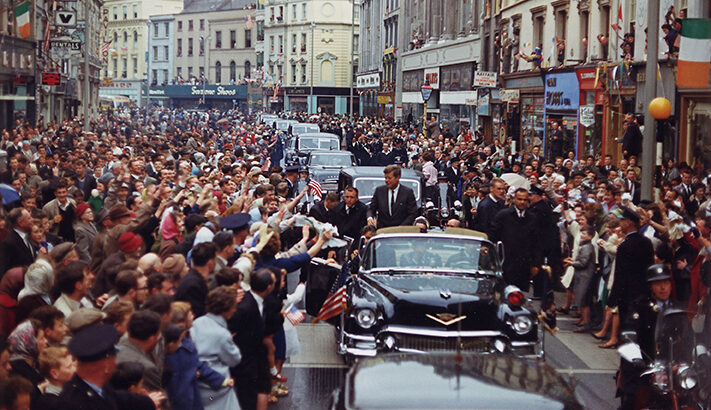Mark Holan
This year’s fraught US presidential campaigns have got many Americans wondering what has become of the once powerful ‘Irish vote’?
This problem comes into even sharper focus with this recently published history of the Irish American strain by Prof. Timothy J. Meagher. Meagher was once associate professor of history at Catholic University of America and the curator of American Catholic History Collections.
His new book makes something of a contrast with an ill-fated book of 60 years ago by journalist William V. Shannon, which was an epitome of Irish America at the time of John F. Kennedy.
The powerful Irish American political machine – from Tammany in New York to Daley in Chicago – that dominated many American cities up to that day was about to disappear.
Meagher describes JFK’s election and martyrdom as the passage from outsider to insider status for Irish American Catholics. But there are limits to “a simple dichotomy between assimilation and ethnic persistence,” he writes.
Shannon’s book, The American Irish came out as 1963 turned into 1964. Its concluding chapter about Kennedy had been written, edited, and printed before the assassination in Dallas less than two months earlier.
Significance
Kennedy’s election had been “charged with a special significance for the American Irish,” wrote Shannon, then a Washington correspondent. “The winning of the presidency culminated and consolidated more than a century of Irish political activity.”
It seemed to wipe away the bitterness and disappointment of Al Smith’s 1928 defeat as the first Irish American Catholic presidential candidate. It “removed any lingering sense of social inferiority and insecurity” from immigrants and their offspring, too long caricatured as ditch-diggers and housemaids.
Kennedy, Shannon wrote, was “not Irish in most of the obvious ways. (He was a Harvard graduate without a brogue, whose wealthy father had been US Ambassador to Britain)”.
Yet he was “in accord with Irish political experience and with the Irish past in other, more fundamental ways,” notably his Catholicism. JFK’s combination of characteristics helped make him the avatar of the American Irish future.
Shannon’s finished his book on March 27, 1963, three months before Kennedy’s historic stop in Ireland, the first by an American president while in office, though not JFK’s first visit to his ancestral homeland.
Tragedy
This triumph, like the tragedy of November 1963, is also absent from Shannon’s book – a copy of which Lyndon Johnson gifted to the American-born Irish President Éamon de Valera during his May 1964 visit to the White House.
The Shannon book was generally well-received by US reviewers, though The Washington Post reviewer suggested that “Despite the emergence of an Irish aristocracy with Kennedy, the assimilation of the common, garden-variety Irish in America remains an unfinished process.”
As the Irish moved from big city wards to the suburbs, Shannon noted in a new edition of his book that ‘it weakened the old stereotypes of the Irish political boss’”
The writer astutely observed that Shannon neglected to address this, much less ask why. This meant “the definitive history of the Irish in America is therefore yet to be written.”
In attempting to answer the assimilation question, the author described “a waning, yet persistent sentiment” among Irish American Catholics of still being targets of discrimination, even as they helped set a “path-breaking” example for the success of other marginalised groups.
As the Irish moved from big city wards to the suburbs, Shannon noted in a new edition of his book that “it weakened the old stereotypes of the Irish political boss” and opened the way for new opportunities, which have been realised since the 1960s by politicians, professionals, even “common, garden-variety” Irish Americans.
Reinvented
In the book to hand Meagher makes a few nods to Shannon, later a US ambassador to Ireland. Irish America has “changed and changed again, invented and reinvented” itself in many ways up to and since Kennedy. The six decades since Dallas have brought “dramatic and fundamental” changes to this high-profile cohort.
“Institutions and alliances which were the very foundation of Irish American Catholic ethnicity have crumbled or withered.” Today, more than 31 million Americans claim Irish ancestry, nearly 10% of the population. Like JFK, many are “not Irish (American) in most of the obvious ways.”
The definitive history of the Irish in America is always being remade and rewritten”
But African Americans, LGBTQ people, the non-religiously affiliated, and other groups are exploring their Irish heritage and culture in new and distinctive ways. Among the US electorate, they were (and are) as likely to vote for Donald Trump as for Joe Biden, the second Irish American Catholic president.
While some old stereotypes linger, once familiar shades of green are fading and blending on the contemporary palette. The definitive history of the Irish in America is always being remade and rewritten, no matter the marker of any news event.
While some old stereotypes linger, once familiar shades of green are fading and blending on the contemporary palette”
Mark Holan is a journalist based in Washington DC. Visit his work at markholan.org


 President Kennedy greeted by crowds in Dublin 1963
President Kennedy greeted by crowds in Dublin 1963 